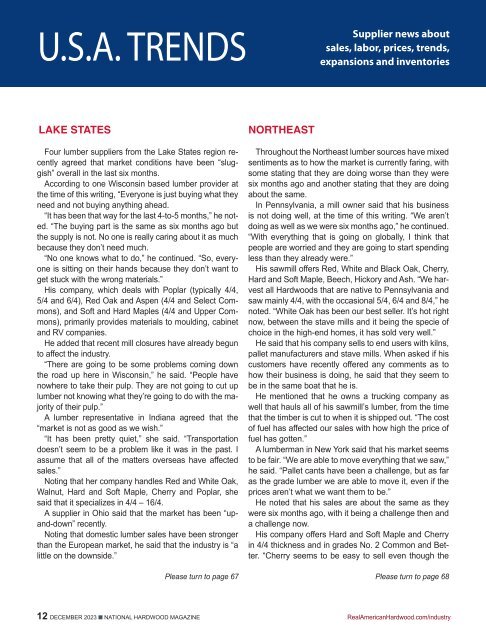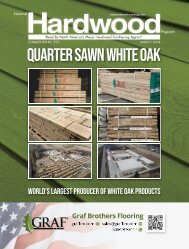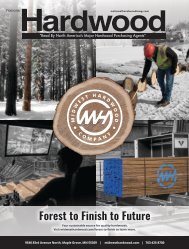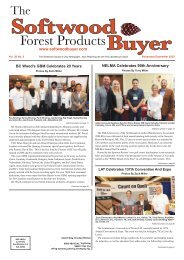National Hardwood Magazine - December 2023
The December 2023 issue of the National Hardwood Magazine features stories on Houston Hardwoods, HHP Inc., and a 2024 industry forecast.
The December 2023 issue of the National Hardwood Magazine features stories on Houston Hardwoods, HHP Inc., and a 2024 industry forecast.
You also want an ePaper? Increase the reach of your titles
YUMPU automatically turns print PDFs into web optimized ePapers that Google loves.
U.S.A. TRENDS<br />
Supplier news about<br />
sales, labor, prices, trends,<br />
expansions and inventories<br />
LAKE STATES<br />
NORTHEAST<br />
SOUTHEAST<br />
WEST COAST<br />
Four lumber suppliers from the Lake States region recently<br />
agreed that market conditions have been “sluggish”<br />
overall in the last six months.<br />
According to one Wisconsin based lumber provider at<br />
the time of this writing, “Everyone is just buying what they<br />
need and not buying anything ahead.<br />
“It has been that way for the last 4-to-5 months,” he noted.<br />
“The buying part is the same as six months ago but<br />
the supply is not. No one is really caring about it as much<br />
because they don’t need much.<br />
“No one knows what to do,” he continued. “So, everyone<br />
is sitting on their hands because they don’t want to<br />
get stuck with the wrong materials.”<br />
His company, which deals with Poplar (typically 4/4,<br />
5/4 and 6/4), Red Oak and Aspen (4/4 and Select Commons),<br />
and Soft and Hard Maples (4/4 and Upper Commons),<br />
primarily provides materials to moulding, cabinet<br />
and RV companies.<br />
He added that recent mill closures have already begun<br />
to affect the industry.<br />
“There are going to be some problems coming down<br />
the road up here in Wisconsin,” he said. “People have<br />
nowhere to take their pulp. They are not going to cut up<br />
lumber not knowing what they’re going to do with the majority<br />
of their pulp.”<br />
A lumber representative in Indiana agreed that the<br />
“market is not as good as we wish.”<br />
“It has been pretty quiet,” she said. “Transportation<br />
doesn’t seem to be a problem like it was in the past. I<br />
assume that all of the matters overseas have affected<br />
sales.”<br />
Noting that her company handles Red and White Oak,<br />
Walnut, Hard and Soft Maple, Cherry and Poplar, she<br />
said that it specializes in 4/4 – 16/4.<br />
A supplier in Ohio said that the market has been “upand-down”<br />
recently.<br />
Noting that domestic lumber sales have been stronger<br />
than the European market, he said that the industry is “a<br />
little on the downside.”<br />
Throughout the Northeast lumber sources have mixed<br />
sentiments as to how the market is currently faring, with<br />
some stating that they are doing worse than they were<br />
six months ago and another stating that they are doing<br />
about the same.<br />
In Pennsylvania, a mill owner said that his business<br />
is not doing well, at the time of this writing. “We aren’t<br />
doing as well as we were six months ago,” he continued.<br />
“With everything that is going on globally, I think that<br />
people are worried and they are going to start spending<br />
less than they already were.”<br />
His sawmill offers Red, White and Black Oak, Cherry,<br />
Hard and Soft Maple, Beech, Hickory and Ash. “We harvest<br />
all <strong>Hardwood</strong>s that are native to Pennsylvania and<br />
saw mainly 4/4, with the occasional 5/4, 6/4 and 8/4,” he<br />
noted. “White Oak has been our best seller. It’s hot right<br />
now, between the stave mills and it being the specie of<br />
choice in the high-end homes, it has sold very well.”<br />
He said that his company sells to end users with kilns,<br />
pallet manufacturers and stave mills. When asked if his<br />
customers have recently offered any comments as to<br />
how their business is doing, he said that they seem to<br />
be in the same boat that he is.<br />
He mentioned that he owns a trucking company as<br />
well that hauls all of his sawmill’s lumber, from the time<br />
that the timber is cut to when it is shipped out. “The cost<br />
of fuel has affected our sales with how high the price of<br />
fuel has gotten.”<br />
A lumberman in New York said that his market seems<br />
to be fair. “We are able to move everything that we saw,”<br />
he said. “Pallet cants have been a challenge, but as far<br />
as the grade lumber we are able to move it, even if the<br />
prices aren’t what we want them to be.”<br />
He noted that his sales are about the same as they<br />
were six months ago, with it being a challenge then and<br />
a challenge now.<br />
His company offers Hard and Soft Maple and Cherry<br />
in 4/4 thickness and in grades No. 2 Common and Better.<br />
“Cherry seems to be easy to sell even though the<br />
Lumber sources throughout the Southeast region are<br />
a mixed bag, with comments ranging from the market<br />
has improved to sales have slowed down.<br />
In Tennessee a sawmill representative said that his<br />
market has improved, at the time of this writing. “We are<br />
doing better than we were six months ago. I think this is<br />
due to supply being down and the demand starting to<br />
pick up.”<br />
His company offers Ash, Cherry, Hard and Soft Maple,<br />
Hickory, Poplar and Red and White Oak in grades FAS,<br />
Nos. 1, 2 and 3A Common. “We are able to offer our<br />
Poplar in 4/4-6/4 thicknesses and White Oak in 4/4 and<br />
6/4 thicknesses, while we offer everything else in 4/4<br />
thickness,” he added. He also mentioned that White Oak<br />
has been a hot item for his company.<br />
His company sells to flooring companies, moulding<br />
and trim manufacturers, distribution centers and furniture<br />
manufacturers, as well as American exporters. “It seems<br />
that the U.S. and domestic business is fairly firm, while<br />
exports into Asia have been slow. Exports to Europe<br />
have been stronger than they have been to Asia lately,”<br />
he noted.<br />
He mentioned that the labor shortage continues to<br />
affect his company to an extent.<br />
In Alabama a lumber spokesperson said his White<br />
Oak sales have been doing well and Ash seems to be<br />
holding its own, while his Red Oak and Poplar sales are<br />
not doing as well.<br />
When asked if his sales were better than they were<br />
six months ago he mentioned that they might be doing a<br />
touch better than they were.<br />
The four main species that his company offers are Red<br />
and White Oak, Poplar and Ash in grades FAS Common<br />
and No. 2A Common and in thicknesses of 4/4 and 5/4.<br />
“We are worldwide, we sell into the international and<br />
the domestic markets,” he said. “Vietnam and China<br />
have both really slowed down and we aren’t hearing<br />
good things about either country.” He also mentioned<br />
that the domestic market wasn’t doing well, at the time<br />
<strong>Hardwood</strong> lumber suppliers on the West Coast reported<br />
stable to busy activity. Niche markets accounted for<br />
increased business while other markets stayed the same<br />
as the previous report. Throughout the region, several<br />
contacts mentioned challenging transportation concerns<br />
and are expecting availability shortages in the near term.<br />
One source in California said <strong>Hardwood</strong> activity is<br />
steady. “We’re seeing stable activity. I don’t know about<br />
our competitors but we haven’t seen much of a change.<br />
It’s been steady the last three months for us.”<br />
Carrying high-end and wider width lumber, he said,<br />
“We set ourselves apart from the commodities. The hospitality<br />
markets are looking for specialty products and<br />
that’s what we carry.”<br />
Carrying every species from Alder to Zebrawood, the<br />
source said the best moving item for his operation currently<br />
is Walnut and White Oak. “It doesn’t matter what<br />
cut, the Oak is moving,” he explained. “Rift cut, plain<br />
sliced, and quarter cut are all moving well in White Oak<br />
and Walnut. Probably our slowest species is Cherry right<br />
now.”<br />
As for transportation, he said availability of trucks has<br />
improved but pricing continues to rise. “We have seen<br />
tremendous increases in fuel prices along with surcharges<br />
that just seem to continue to rise,” he said.<br />
Looking ahead, the contact expects his market to remain<br />
the same but doesn’t think the same is true for<br />
commodity markets. “It’s a hard market if you’re not a<br />
specialty supplier right now. Due to prices of fuel rising<br />
and availability tightening, not everyone is willing to pay<br />
those increases.”<br />
“Most of our customers are booked for the next few<br />
months,” a contact in Washington noted. One issue that<br />
challenges them, he added, is “freight costs are starting<br />
to go back up because of fuel cost.”<br />
The <strong>Hardwood</strong> supplier, who handles mostly White<br />
Oak, said he expects lumber shortages in the coming<br />
months. “We’ll probably see some shortages in the<br />
whitewoods, such as the Maples and Walnut. Walnut<br />
Please turn to page 67 Please turn to page 68<br />
Please turn to page 68 Please turn to page 69<br />
12 DECEMBER <strong>2023</strong> n NATIONAL HARDWOOD MAGAZINE RealAmerican<strong>Hardwood</strong>.com/industry<br />
RealAmerican<strong>Hardwood</strong>.com/industry<br />
DECEMBER <strong>2023</strong> n NATIONAL HARDWOOD MAGAZINE 13

















